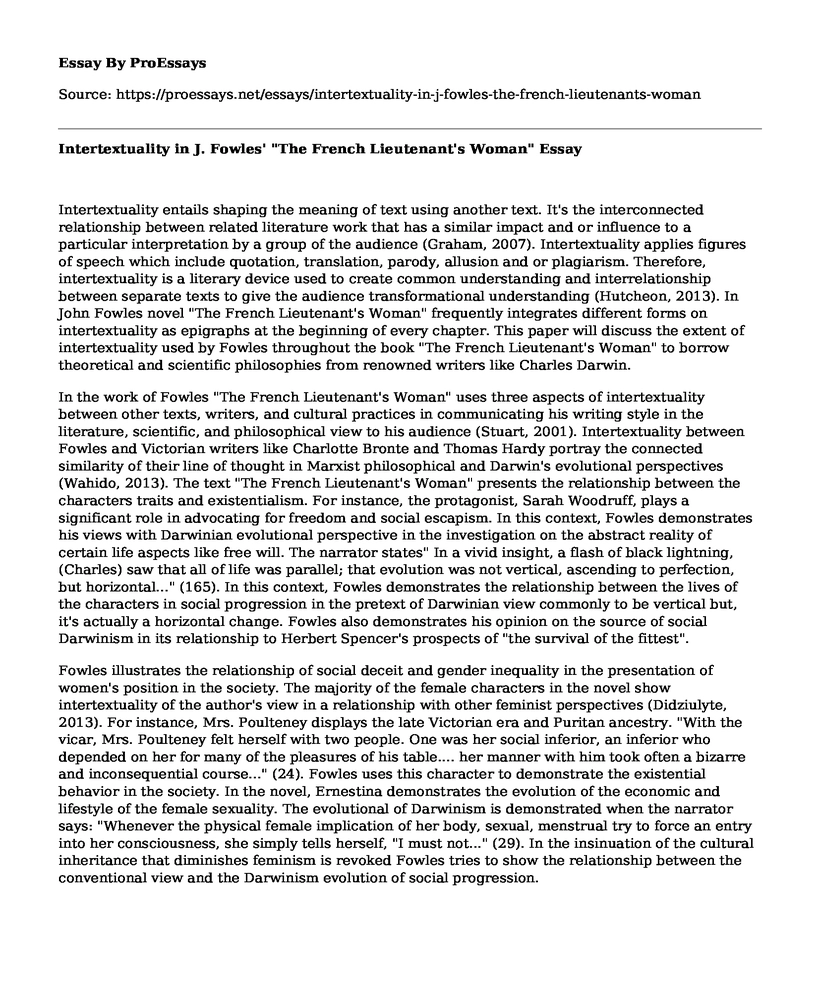Intertextuality entails shaping the meaning of text using another text. It's the interconnected relationship between related literature work that has a similar impact and or influence to a particular interpretation by a group of the audience (Graham, 2007). Intertextuality applies figures of speech which include quotation, translation, parody, allusion and or plagiarism. Therefore, intertextuality is a literary device used to create common understanding and interrelationship between separate texts to give the audience transformational understanding (Hutcheon, 2013). In John Fowles novel "The French Lieutenant's Woman" frequently integrates different forms on intertextuality as epigraphs at the beginning of every chapter. This paper will discuss the extent of intertextuality used by Fowles throughout the book "The French Lieutenant's Woman" to borrow theoretical and scientific philosophies from renowned writers like Charles Darwin.
In the work of Fowles "The French Lieutenant's Woman" uses three aspects of intertextuality between other texts, writers, and cultural practices in communicating his writing style in the literature, scientific, and philosophical view to his audience (Stuart, 2001). Intertextuality between Fowles and Victorian writers like Charlotte Bronte and Thomas Hardy portray the connected similarity of their line of thought in Marxist philosophical and Darwin's evolutional perspectives (Wahido, 2013). The text "The French Lieutenant's Woman" presents the relationship between the characters traits and existentialism. For instance, the protagonist, Sarah Woodruff, plays a significant role in advocating for freedom and social escapism. In this context, Fowles demonstrates his views with Darwinian evolutional perspective in the investigation on the abstract reality of certain life aspects like free will. The narrator states" In a vivid insight, a flash of black lightning, (Charles) saw that all of life was parallel; that evolution was not vertical, ascending to perfection, but horizontal..." (165). In this context, Fowles demonstrates the relationship between the lives of the characters in social progression in the pretext of Darwinian view commonly to be vertical but, it's actually a horizontal change. Fowles also demonstrates his opinion on the source of social Darwinism in its relationship to Herbert Spencer's prospects of "the survival of the fittest".
Fowles illustrates the relationship of social deceit and gender inequality in the presentation of women's position in the society. The majority of the female characters in the novel show intertextuality of the author's view in a relationship with other feminist perspectives (Didziulyte, 2013). For instance, Mrs. Poulteney displays the late Victorian era and Puritan ancestry. "With the vicar, Mrs. Poulteney felt herself with two people. One was her social inferior, an inferior who depended on her for many of the pleasures of his table.... her manner with him took often a bizarre and inconsequential course..." (24). Fowles uses this character to demonstrate the existential behavior in the society. In the novel, Ernestina demonstrates the evolution of the economic and lifestyle of the female sexuality. The evolutional of Darwinism is demonstrated when the narrator says: "Whenever the physical female implication of her body, sexual, menstrual try to force an entry into her consciousness, she simply tells herself, "I must not..." (29). In the insinuation of the cultural inheritance that diminishes feminism is revoked Fowles tries to show the relationship between the conventional view and the Darwinism evolution of social progression.
Conclusion
In conclusion, Fowles use of intertextuality to reference the plot of the story in "The French Lieutenant's Woman" to Charles Darwin's evolutionary philosophy to develop the character traits. The entire text emphasizes the social progression of the characters on a horizontal scale in the convention of time demonstrating the aftermaths of their changes.
Works cited
Didziulyte, Margarita. Imitation and Parody of the Victorian Novel in John Fowles' The French Lieutenant's Woman, Vilnius, 2006. DART -Europe E- Theses Portal. Web. 17 March 2013.
Fowles, John. The French Lieutenant's Woman. London: Vintage Books, 2004. Print.
Graham, Allan. Intertextuality: the New Critical Idiom. London and New York: Routledge, 2007. Print.
Hutcheon, Linda. A Poetics of Postmodernism: History, Theory, Fiction. New York, 2004.
Google Book Search. Web. 17 March 2013.
Stuart, Sim. The Routledge companion to Postmodernism. London: Routledge, 2001. Print.
Wahido, Hasina. Interfacing Texts and Paratexts: John Fowles' The French Lieutenant's Woman.
Germany, 2012. Google Book Search. Web. 17 March 2013.
Cite this page
Intertextuality in J. Fowles' "The French Lieutenant's Woman". (2022, May 17). Retrieved from https://proessays.net/essays/intertextuality-in-j-fowles-the-french-lieutenants-woman
If you are the original author of this essay and no longer wish to have it published on the ProEssays website, please click below to request its removal:
- Comparative Essay on Macbeth, Mr Hyde and Frankenstein Characters
- Shout by Dagoberto Gilb Essay
- Literary Analysis Essay on Gain and Loss in 'Paradise Lost' by John Milton
- The Short Story of Junot Diaz Essay Example
- Understanding Ralph Ellison's Invisible Man Paper Example
- John Donne: Master of Contradiction and Theology - Research Paper
- Essay Sample on The Yellow Paper: A Woman's Battle Against Oppression in 1892







